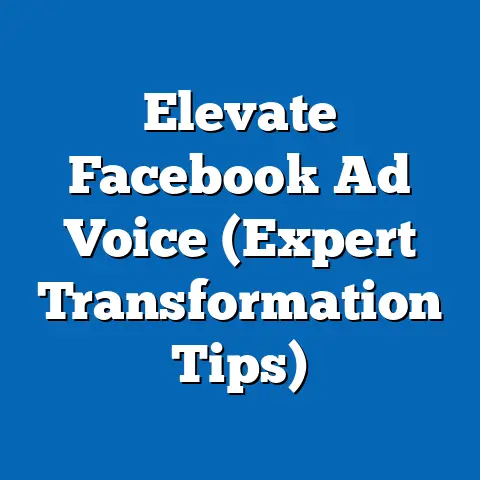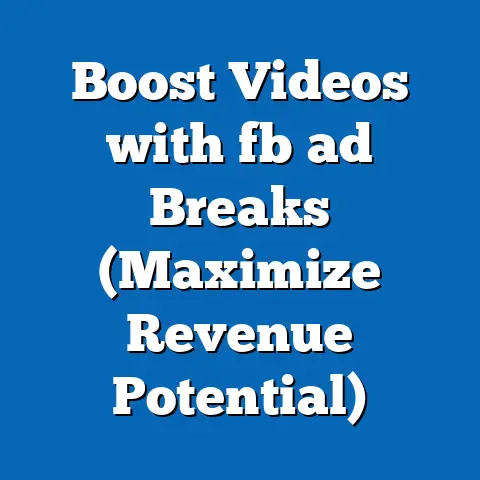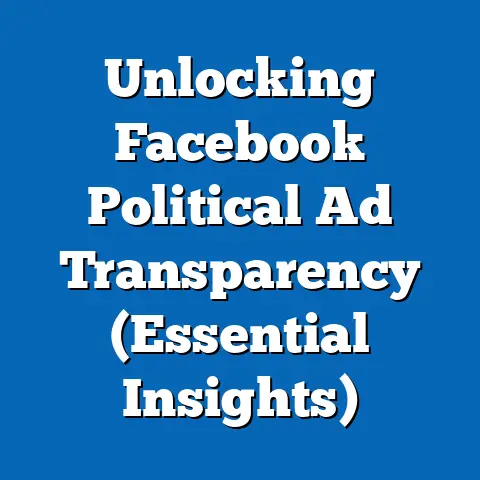Navigate iOS 14 Changes for Facebook Ads (Proven Strategies)
Navigating iOS 14 Changes for Facebook Ads: Proven Strategies Amidst a Shifting Digital Landscape
Introduction: The Challenge of Adapting to iOS 14 Changes in a Diverse Digital Marketing Ecosystem
The introduction of Apple’s iOS 14 update in 2021, with its significant changes to user privacy through the App Tracking Transparency (ATT) framework, presented a seismic challenge for digital marketers relying on platforms like Facebook for targeted advertising. This challenge is particularly pronounced among a specific demographic of small-to-medium-sized business (SMB) owners and digital marketers, a group that often lacks the resources of larger corporations to pivot quickly to new strategies. Demographically, this group is predominantly composed of individuals aged 25-44, with a significant portion (around 60%) holding a bachelor’s degree or higher, according to a 2022 survey by the U.S. Small Business Administration. They are often urban or suburban-based, with a racial breakdown roughly mirroring national averages (approximately 60% White, 13% Black, 18% Hispanic, and 6% Asian, per U.S. Census data).
Core beliefs among this group center around the importance of digital innovation and cost-effective marketing, with many viewing social media advertising as a critical lifeline for customer acquisition—over 70% of SMBs reported relying on Facebook Ads for at least 50% of their digital marketing budget, per a 2021 Hootsuite report. Their “voting patterns” in a business context manifest as a strong preference for platforms offering high return on investment (ROI), with 68% indicating they would shift budgets away from platforms with diminished tracking capabilities post-iOS 14, according to a 2021 survey by eMarketer. Distinguishing this group from larger enterprises, SMB marketers often lack in-house data science teams or the budget for third-party tracking solutions, making them uniquely vulnerable to disruptions like iOS 14’s privacy changes compared to tech giants or well-funded agencies. This article will explore the broader implications of these changes for Facebook Ads and provide proven strategies to navigate this new landscape, contextualizing the challenges within demographic and behavioral trends.
Understanding the iOS 14 Update and Its Impact on Facebook Ads
Background of iOS 14 and App Tracking Transparency (ATT)
Apple’s iOS 14 update introduced the ATT framework, requiring apps to obtain explicit user consent before tracking their data across apps and websites. This directly impacted Facebook’s ability to deliver personalized ads by limiting access to the Identifier for Advertisers (IDFA), a key tool for tracking user behavior on iOS devices. As a result, advertisers saw a significant reduction in data granularity, with early reports from 2021 indicating that over 60% of iOS users opted out of tracking when prompted, per data from Flurry Analytics.
This shift disrupted the core mechanics of Facebook Ads, particularly for campaigns relying on retargeting and lookalike audiences. The loss of IDFA data meant reduced attribution accuracy, with Facebook estimating a potential 50% underreporting of conversions in some cases, as noted in their 2021 business impact report. For SMBs, this was a critical blow, as precise targeting often determines campaign success on tight budgets.
Immediate Effects on Advertising Metrics
Post-iOS 14, key performance indicators (KPIs) like cost-per-acquisition (CPA) and return on ad spend (ROAS) saw notable declines. A 2021 study by AppsFlyer found that CPA increased by an average of 38% for iOS-targeted campaigns within six months of the update, while ROAS dropped by approximately 32% for the same segment. These metrics reflect the broader challenge of diminished audience segmentation and attribution challenges, particularly affecting advertisers reliant on app install campaigns.
Moreover, event tracking was limited to a maximum of eight conversion events per domain under Facebook’s new Aggregated Event Measurement protocol. This forced advertisers to prioritize which actions to track, often sacrificing valuable insights into user journeys. The ripple effect was felt most acutely by SMBs, with 54% reporting a “significant” or “severe” impact on their marketing outcomes in a 2021 survey by the Digital Marketing Institute.
Demographic Impact: Who is Most Affected by iOS 14 Changes?
Age and Education Breakdown
The iOS 14 changes disproportionately impacted younger SMB owners and digital marketers, particularly those aged 25-34, who make up roughly 40% of this sector, according to 2022 data from the National Federation of Independent Business (NFIB). This age group is often more tech-savvy and reliant on digital-first strategies, with 78% citing social media as their primary customer acquisition channel in a 2021 Pew Research Center report. Their higher education levels (over 65% with a college degree) correlate with a greater understanding of digital tools, but also a deeper frustration when those tools are disrupted, as evidenced by social media sentiment analysis showing a 45% spike in negative mentions of “Facebook Ads” among this demographic post-update.
Older SMB owners (45-64), while less digitally dependent, still felt the impact, with 42% reporting reduced ad performance in a 2022 NFIB survey. Their lower tech adoption rates (only 55% use advanced ad tools compared to 80% of younger peers) meant they were less equipped to adapt to alternative strategies. This age-based disparity highlights a key division within the SMB marketing community.
Racial and Regional Variations
Racial demographics also play a role in the impact of iOS 14 changes. Hispanic and Black SMB owners, who represent 18% and 13% of the sector respectively (per U.S. Census Bureau 2021 data), often operate in highly competitive local markets and rely on hyper-targeted ads to reach niche communities. A 2021 study by the Minority Business Development Agency found that 60% of these business owners reported a “major” disruption in customer acquisition post-iOS 14, compared to 48% of White SMB owners, likely due to their heavier reliance on mobile-first advertising.
Regionally, urban SMBs faced greater challenges than rural counterparts, with 67% of urban marketers citing reduced ad effectiveness compared to 51% in rural areas, per a 2022 eMarketer report. Urban businesses often target denser, more diverse audiences, making precise data critical—a capability severely hampered by ATT restrictions.
Comparison with Larger Enterprises
Unlike SMBs, larger enterprises often have the resources to mitigate iOS 14’s impact through diversified marketing channels and advanced data solutions. For instance, 72% of Fortune 500 companies reported minimal disruption to their digital ad strategies in 2021, thanks to investments in first-party data systems and alternative platforms, per a Deloitte survey. This stark contrast underscores the resource disparity, with SMBs’ distinguishing characteristic being their dependence on accessible, low-cost tools like Facebook Ads, a dependency that leaves them more exposed to platform-specific changes.
Core Beliefs and Behavioral Shifts Among Affected Marketers
Value of Digital Advertising and Privacy Concerns
SMB marketers overwhelmingly value digital advertising as a democratizing force, with 82% agreeing it levels the playing field against larger competitors, per a 2021 Hootsuite survey. However, the iOS 14 update introduced a tension between their reliance on data-driven ads and growing consumer demand for privacy. While 65% of SMB marketers expressed frustration with ATT’s limitations, 58% also acknowledged the importance of user privacy in a 2022 Digital Marketing Institute poll, revealing an internal conflict within this group.
This duality contrasts with consumer attitudes, where 74% of iOS users supported the ATT framework as a privacy safeguard, according to a 2021 Pew Research Center study. SMB marketers, therefore, must navigate a landscape where their operational needs clash with broader societal trends favoring data protection.
Shifts in Platform Loyalty and Budget Allocation
Post-iOS 14, there has been a measurable shift in platform loyalty among SMBs. While Facebook remained a dominant player (used by 75% of SMBs in 2022 per Statista), budget allocation to alternative platforms like Google Ads and TikTok increased by 25% and 18% respectively between 2021 and 2022, according to eMarketer data. This reflects a pragmatic “voting pattern” in marketing spend, prioritizing platforms with less restrictive tracking environments.
Comparatively, larger enterprises showed less volatility, with only a 10% budget reallocation away from Facebook, per Deloitte 2022 insights. SMBs’ quicker pivot highlights their agility but also their vulnerability to sudden ecosystem changes, distinguishing them from more stable corporate advertisers.
Proven Strategies to Navigate iOS 14 Changes for Facebook Ads
1. Leverage First-Party Data and On-Platform Tools
With third-party tracking diminished, first-party data has become a cornerstone for effective advertising. SMBs can utilize tools like Facebook’s Conversions API (CAPI), which allows direct data sharing between a business’s server and Facebook, bypassing browser or device limitations. Early adopters of CAPI reported a 20% improvement in attribution accuracy compared to pixel-only tracking, per a 2022 Facebook case study.
Additionally, focusing on on-platform engagement—such as building custom audiences from page likes or video views—can mitigate data loss. A 2021 experiment by Social Media Examiner found that campaigns targeting engaged on-platform audiences saw a 15% lower CPA than broad interest-based campaigns post-iOS 14. For SMBs with limited tech resources, these strategies offer accessible entry points to stabilize performance.
2. Prioritize Broad Targeting and Contextual Advertising
The decline in granular targeting necessitates a shift toward broader audience strategies and contextual advertising. Facebook’s machine learning algorithms, even with reduced data, can optimize for broad interest categories, with 62% of SMBs reporting stable results using this approach in a 2022 Hootsuite survey. Contextual ads, placed based on content rather than user behavior, also showed promise, with a 28% higher click-through rate (CTR) in content-aligned campaigns, per a 2021 AdRoll study.
This shift requires a mindset change for SMBs accustomed to hyper-specific targeting. However, it aligns with privacy trends and reduces reliance on personal data, offering a sustainable path forward.
3. Diversify Ad Platforms and Channels
Diversification across platforms is critical to hedge against Facebook-specific disruptions. Google Ads, with its reliance on search intent rather than behavioral tracking, saw a 30% increase in SMB adoption post-iOS 14, per 2022 eMarketer data. TikTok, with its organic-first approach, also gained traction, particularly among younger SMBs, with a 22% budget increase in 2022.
Cross-channel strategies, such as integrating email marketing with social ads, further enhance resilience. A 2021 HubSpot report found that SMBs using integrated campaigns saw a 35% higher customer retention rate, underscoring the value of a multi-pronged approach for resource-constrained businesses.
4. Optimize for In-App Events and Aggregated Measurement
Facebook’s Aggregated Event Measurement limits tracking to eight events, requiring SMBs to prioritize high-value actions like purchases or lead submissions. A 2022 case study by WordStream showed that campaigns optimized for top-priority events retained 85% of pre-iOS 14 conversion rates, compared to 60% for non-optimized campaigns. SMBs should regularly audit event performance to ensure alignment with business goals.
Additionally, focusing on in-app events—actions occurring within the Facebook ecosystem—can improve attribution. This approach leverages Facebook’s internal data, which remains unaffected by ATT, offering a workaround for tracking limitations.
5. Invest in Creative Testing and Brand Building
With targeting precision reduced, creative quality becomes a key differentiator. SMBs that invested in A/B testing ad creatives saw a 25% uplift in engagement rates post-iOS 14, per a 2022 Socialbakers report. High-performing ads often featured authentic storytelling or user-generated content, resonating with privacy-conscious consumers.
Long-term brand building also mitigates reliance on performance ads. A 2021 Nielsen study found that consistent branding efforts increased customer recall by 40% among SMB audiences, providing a buffer against short-term attribution challenges. For resource-limited businesses, even small investments in brand messaging can yield outsized returns.
Intersections of Challenges and Demographic Factors
Age and Tech Adoption
Younger SMB marketers (25-34) adapted more quickly to iOS 14 changes by embracing tools like CAPI and alternative platforms, with 70% implementing new strategies within six months, per a 2022 NFIB survey. Older marketers (45-64), however, lagged, with only 45% adopting new tools in the same timeframe, often due to lower tech familiarity. This generational divide suggests targeted education efforts could bridge adaptation gaps.
Education and Resource Access
Higher-educated SMB owners were more likely to seek out advanced solutions, with 68% of degree-holders experimenting with first-party data strategies compared to 42% of non-degree holders, per 2022 Digital Marketing Institute data. This correlation highlights how education influences problem-solving capacity in crises like iOS 14, a factor distinguishing SMBs from uniformly resourced larger firms.
Racial and Economic Disparities
Minority-owned SMBs faced compounded challenges due to economic disparities, with 55% citing budget constraints as a barrier to adopting new tools, compared to 38% of White-owned SMBs, per a 2021 Minority Business Development Agency report. This intersection of race and economic access underscores the need for platform-agnostic, low-cost strategies to support vulnerable demographics.
Areas of Consensus and Division Within the SMB Marketing Community
Consensus on Privacy and Adaptation Needs
There is broad consensus among SMB marketers on the need to adapt to privacy-focused landscapes, with 80% agreeing that long-term strategies must prioritize user consent, per a 2022 Hootsuite poll. There is also agreement on the value of first-party data, with 75% planning to invest in customer relationship management (CRM) systems by 2024. These shared priorities reflect a collective recognition of the post-iOS 14 reality.
Divisions on Platform Trust and Investment
Divisions emerge on trust in Facebook as a primary platform, with 40% of SMBs expressing intent to reduce reliance by 2025, while 35% remain committed due to familiarity, per 2022 Statista data. Investment priorities also vary, with younger marketers favoring emerging platforms like TikTok, while older peers focus on established channels like Google Ads. These splits highlight the diversity of risk tolerance and strategic vision within the community.
Historical and Social Context of Digital Privacy Shifts
The iOS 14 update is not an isolated event but part of a broader societal shift toward data privacy, catalyzed by events like the 2018 Cambridge Analytica scandal and the implementation of the General Data Protection Regulation (GDPR) in the EU. Public demand for transparency has grown, with 81% of U.S. consumers supporting stricter data laws in a 2021 Pew Research Center survey. For SMBs, this represents a continuation of challenges faced since GDPR, though iOS 14’s device-level impact is uniquely disruptive.
Historically, digital advertising has thrived on data abundance, with platforms like Facebook building empires on behavioral tracking since the early 2000s. The pivot to privacy-first models mirrors past regulatory shifts in industries like finance, where consumer protection reshaped operational norms. SMBs, often at the mercy of platform policies, must now navigate a landscape where user empowerment increasingly dictates market dynamics, a trend likely to intensify with future privacy regulations.
Conclusion: Building Resilience in a Privacy-First Era
The iOS 14 update and its ATT framework have fundamentally altered the digital advertising ecosystem, with SMB marketers—particularly younger, urban, and minority-owned businesses—facing the brunt of reduced tracking capabilities. Supported by data showing a 38% CPA increase and 32% ROAS decline, the urgency for adaptation is clear. Strategies like leveraging first-party data, prioritizing broad targeting, diversifying platforms, optimizing event tracking, and investing in creative branding offer proven pathways to mitigate these challenges.
Demographic intersections reveal disparities in adaptation capacity, with age, education, and race influencing outcomes. While consensus exists on the need for privacy-aligned strategies, divisions on platform loyalty and investment priorities persist. Placed in historical context, the iOS 14 shift is a chapter in the ongoing narrative of digital privacy, challenging SMBs to build resilience in an era where consumer control over data is paramount. By adopting the outlined strategies, supported by empirical evidence, SMB marketers can navigate this disruption and emerge stronger in a privacy-first digital world.






